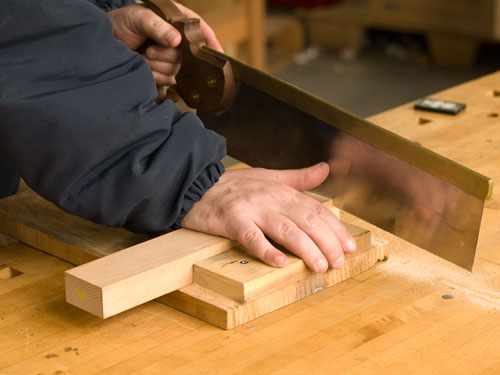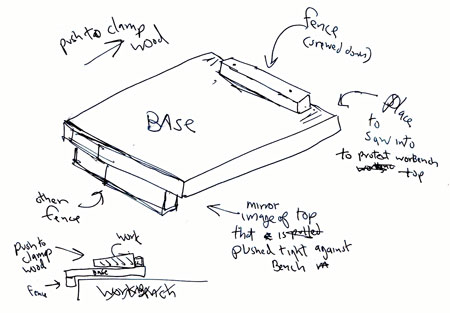 The bench stop is possibly the most important of all the sawing aids there are. Mine leans against my bench leg so that it's always within arm's reach. I use it for all crosscutting and sometimes as a stop for chiseling and other small operations. To use it for sawing one hand forces the wood against the fence and also guides the position of the saw. It's second nature after 5 minutes practice. Some design guide lines: The bench stop is possibly the most important of all the sawing aids there are. Mine leans against my bench leg so that it's always within arm's reach. I use it for all crosscutting and sometimes as a stop for chiseling and other small operations. To use it for sawing one hand forces the wood against the fence and also guides the position of the saw. It's second nature after 5 minutes practice. Some design guide lines:
1 - The fence is short of the width of the base so that you saw into the base. Do not overhang the base and saw over your bench. Sawing into the base of the bench stop gives you a nice clean exit from the saw on the work - no splinters and it protects your bench and saw from that last cut digging into the benchtop. In the photo is one of the bench stops we use in the ship. The fence is short on both sides so that either a righty or lefty can use it. (I'm a lefty.)
2 - The fence is screwed into the base, never glued, so that as you wear out the base on the ends where the saw cuts into it you just trim a little off from the fence and renew the base that way. By trimming the fences and flipping the bench stop to use both sides even though a bench stop is an expendable accessory it will last for years in the shop.
3 - Use scrap. You are cutting into the bench stop, dimensions don't really matter, use whatever you have at hand. Don't think to much about it. I don't recommend using MDF or even plywood as since you do saw into the base there is no point in dulling your saws in the glue in the wood.
4 - I have seen people use the end of the fence as a cutting guide for the saw or even cut miter guides in the fence. This is a waste of time. In general with a little practice you will be sawing dead square anyway and for critical cuts you need to shoot the cut anyway so trying to line up the cut just at the end of the fence is hard and doesn't really ensure accuracy. Same thing with mitering - it's not accurate enough and a real miter box will work better if you need one.

|
 Joel's Blog
Joel's Blog Built-It Blog
Built-It Blog Video Roundup
Video Roundup Classes & Events
Classes & Events Work Magazine
Work Magazine


 The bench stop is possibly the most important of all the sawing aids there are. Mine leans against my bench leg so that it's always within arm's reach. I use it for all crosscutting and sometimes as a stop for chiseling and other small operations. To use it for sawing one hand forces the wood against the fence and also guides the position of the saw. It's second nature after 5 minutes practice. Some design guide lines:
The bench stop is possibly the most important of all the sawing aids there are. Mine leans against my bench leg so that it's always within arm's reach. I use it for all crosscutting and sometimes as a stop for chiseling and other small operations. To use it for sawing one hand forces the wood against the fence and also guides the position of the saw. It's second nature after 5 minutes practice. Some design guide lines:
My benchstop looks similar, except that the fence is midway rather than at the far end. This way I can also use it with Japanese saws (placing the board on the far side for the pull saw action).
Regards from Perth
Derek
Thanks for the suggestion. I have another bench stop almost like you describe for Japanese saws - Woodworking Magazine published a tip from me years ago on that version - except now I don't use Japanese saws much and I don't use that version much now.